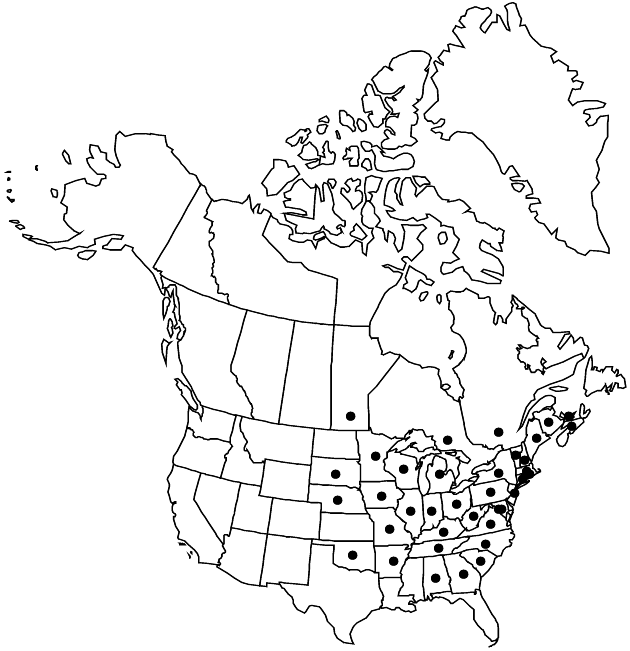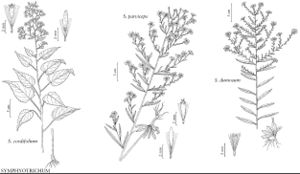Difference between revisions of "Symphyotrichum cordifolium"
Phytologia 77: 278. 1995.
FNA>Volume Importer |
imported>Volume Importer |
||
| (One intermediate revision by the same user not shown) | |||
| Line 8: | Line 8: | ||
}} | }} | ||
|common_names=Heartleaf or common blue wood aster;aster cordifolié | |common_names=Heartleaf or common blue wood aster;aster cordifolié | ||
| + | |special_status={{Treatment/ID/Special_status | ||
| + | |code=F | ||
| + | |label=Illustrated | ||
| + | }}{{Treatment/ID/Special_status | ||
| + | |code=E | ||
| + | |label=Endemic | ||
| + | }} | ||
|basionyms={{Treatment/ID/Basionym | |basionyms={{Treatment/ID/Basionym | ||
|name=Aster cordifolius | |name=Aster cordifolius | ||
| Line 153: | Line 160: | ||
|publication title=Phytologia | |publication title=Phytologia | ||
|publication year=1995 | |publication year=1995 | ||
| − | |special status= | + | |special status=Illustrated;Endemic |
| − | |source xml=https:// | + | |source xml=https://bitbucket.org/aafc-mbb/fna-data-curation/src/2e0870ddd59836b60bcf96646a41e87ea5a5943a/coarse_grained_fna_xml/V19-20-21/V20_1123.xml |
|tribe=Asteraceae tribe Astereae | |tribe=Asteraceae tribe Astereae | ||
|genus=Symphyotrichum | |genus=Symphyotrichum | ||
Latest revision as of 19:58, 5 November 2020
Perennials, 20–120 cm, colonial or cespitose; branched rhizomatous, or with branched caudices, becoming ± woody. Stems 1–5+, erect (straight to ± flexuous distally, often reddish, sometimes brown), usually glabrous, sometimes ± pilose, particularly distally. Leaves thin, margins serrate (often sharply, teeth acuminate, mucronulate) to serrate-crenate or subentire, strigose, apices acuminate to acute, mucronulate, abaxial faces glabrous or sparsely to densely strigose-pilose, often pilose on midveins, sometimes on other veins also, adaxial glabrous or sparsely to densely strigose, sometimes ± scabrous; basal withering by flowering, new vernal rosettes often present, long-petiolate (petioles ± narrowly winged, bases dilated, sheathing, ciliate), blades ovate to elliptic or suborbiculate, (10–)35–150 × (10–)25–75 mm, bases usually deeply cordate, sometimes rounded, margins coarsely, often irregularly serrate, apices sometimes obtuse or rounded; proximal cauline often withering by flowering, winged-petiolate (becoming shorter and more widely winged distally, petiole bases clasping), blades widely to narrowly ovate, 40–100(–140) × 20–40(–70) mm, reduced distally, bases ± deeply cordate to rounded, margins sharply serrate, apices acuminate; distal usually sessile or subsessile, rarely short-petiolate, blades ovate to lanceolate, 5–105 × 2–45 mm, bases cordate or rounded to attenuate or cuneate, margins serrate or entire (distalmost), apices acuminate. Heads [(5–)20–300+] in ± densely paniculiform arrays, branches divaricate to ascending, paniculiform, sometimes ± long-arching, leafy. Peduncles 0.3–2 cm, ± pilose, bracts linear-oblanceolate or -lanceolate to linear, foliaceous, distally grading into phyllaries, margins sparsely ciliolate, glabrous. Involucres cylindro-campanulate to cylindric, (3–)4.5–5(–6) mm. Phyllaries in (3–)4–6 series, linear-lanceolate to oblong-lanceolate, unequal, bases indurate 1/2–3/4, margins scarious, erose, hyaline, sparsely ciliolate, green zones lanceolate to ± diamond-shaped, apical, apices (often red-tipped) acute to obtuse-acuminate or acuminate, mucronulate, faces glabrous or sparsely strigillose. Ray florets (8–)10–16(–20); corollas usually blue to purple, seldom whitish or pink, laminae (5–)6–8(–10) × 1.4–1.8 mm. Disc florets (8–)10–15(–20); corollas cream-color or light yellow becoming purple, (3–)4–4.5(–5) mm, tubes slightly shorter than funnelform throats, lobes sometimes ± spreading, narrowly triangular to lanceolate, 0.6–0.9 mm. Cypselae dull purple or light brown, obovoid, ± compressed, 2–2.5 mm, 4–5-nerved, faces glabrous; pappi white or ± rose-tinged, 2.5–4.5 mm. 2n = 16, 32.
Phenology: Flowering Aug–Oct.
Habitat: Rich, mostly mesic, rocky to loamy soils, open wooded slopes and bluffs, stream banks, moist ledges, swampy woods, border of beech-maple or oak-hickory forets, clearings, thickets, roadsides, along ditches, sometimes weedy in urban areas
Elevation: 0–1200 m
Distribution

Man., N.B., N.S., Ont., P.E.I., Que., Ala., Ark., Conn., D.C., Ga., Ill., Ind., Iowa, Ky., Maine, Md., Mass., Mich., Minn., Mo., Nebr., N.H., N.J., N.Y., N.C., Ohio, Okla., Pa., R.I., S.C., S.Dak., Tenn., Vt., Va., W.Va., Wis.
Discussion
Symphyotrichum cordifolium has been introduced in British Columbia but has not persisted. In a morphometric analysis of infraspecific variation in the northeastern part of the range, A. Legault (1986) showed that the varieties described are not distinct and mostly represent phenotypic variants caused by growing conditions; likewise, diploid and tetraploid races could not be distinguished morphologically.
The type of Aster cordifolius var. laevigatus is conspecific with that of Symphyotrichum cordifolium. This name is the basionym of S. lowrieanum; therefore the latter cannot be considered distinct from S. cordifolium and is not recognized here. Most specimens initially identified as S. lowrieanum in herbaria have been re-determined as S. cordifolium. Some of the specimens, however, appear to correspond to the hybrid between S. cordifolium and S. laeve var. laeve, called S. ×schistosum (Steele) G. L. Nesom (syn. Aster schistosus Steele).
Symphyotrichum ×tardiflorum (Linnaeus) Greuter, Aghababian & Wagenitz [syn. Aster tardiflorus Linnaeus, A. novi-belgii Linnaeus subsp. tardiflorus (Linnaeus) A. G. Jones, A. novi-belgii var. tardiflorus (Linnaeus) A. G. Jones, Symphyotrichum novi-belgii (Linnaeus) G. L. Nesom var. tardiflorum (Linnaeus) G. L. Nesom] is the F1 hybrid between S. cordifolium and S. puniceum (J. Labrecque & Brouillet 1996; G. L. Nesom 1997; W. Greuter et al. 2005). Aster tardiflorus forma vestitus (Fernald) Fernald or var. vestitus Fernald is a hairy variant of the hybrid and is not recognized here; hairiness may be related to whichever species is the maternal parent. A. G. Jones (1989) reported hybrids with S. drummondii and S. urophyllum. She believed that var. moratum may be a hybrid with or an introgressant from S. drummondii, but this is not accepted by all authors. Symphyotrichum ×finkii (Rydberg) G. L. Nesom (syn. Aster finkii Rydberg), may be the hybrid of S. cordifolium and S. shortii. All such putative hybrids need to be confirmed.
